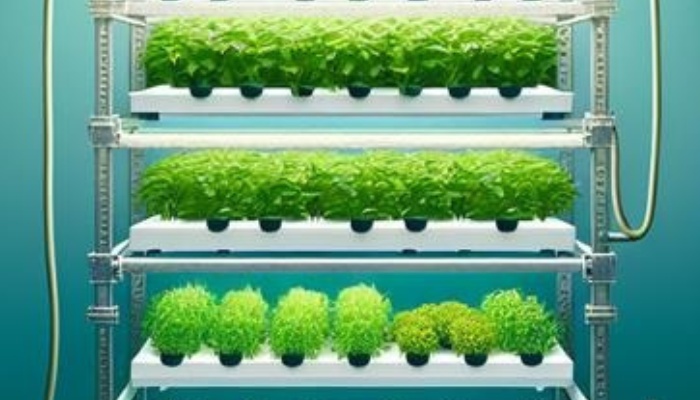Preventing algae in your hydroponic system is essential for the health and productivity of your plants. Algae can swiftly overrun a system, competing with your plants for vital nutrients and light, leading to poor growth or even plant death.
By understanding the causes and implementing strategies such as light management, nutrient solution control, and system cleaning practices, you’ll be well on your way to maintaining a healthy, algae-free environment.
Understand Algae Causes
To effectively prevent algae growth in hydroponic systems, you need to understand that algae thrive in environments with ample light, nutrients, and stagnant water.
You must closely monitor and adjust two critical factors: water temperature and pH levels. Algae proliferation is significantly influenced by these conditions.
First, consider water temperature. Algae favor warm water, typically flourishing between 68°F and 86°F. To hinder algae’s growth, you’ll need to maintain your hydroponic system’s water temperature below this range.
This can be challenging, but using water chillers or adjusting your system’s environment to keep temperatures in check is essential.
Next, pH levels play a pivotal role. Algae prefer a wide pH range, but they’re most prolific in slightly alkaline conditions.
Regularly testing and adjusting the pH of your hydroponic solution to stay slightly acidic, around 5.5 to 6.5, can help suppress algae development. This requires precision, as straying too far from these levels can harm your plants.
Light Management Strategies
Effective light management is essential for controlling algae growth within your hydroponic system and requires strategic planning and implementation of light-blocking techniques.
Incorporating reflective surfaces around your hydroponic setup not only maximizes the efficiency of artificial lighting for plant growth but also prevents light from reaching areas where algae might thrive.
Reflective materials can be placed strategically to direct light away from nutrient solutions and other vulnerable surfaces, thereby inhibiting algae proliferation.
In addition to reflective surfaces, shade structures play a pivotal role in controlling light exposure. These structures are particularly useful in outdoor hydroponic systems or greenhouses where natural sunlight can be both a blessing and a curse.
By employing shade structures, you can precisely regulate the amount of sunlight hitting your system. This ensures plants receive the necessary light for photosynthesis while minimizing the light available to algae.
This targeted approach requires a careful balance; too much shade could hamper plant growth, but too little shade encourages algae.
Both reflective surfaces and shade structures must be thoughtfully integrated into your hydroponic system design.
Analyzing the light dynamics of your setup allows for the tailored application of these strategies, ensuring optimal plant growth without succumbing to algae overgrowth.
Nutrient Solution Control
Managing your hydroponic system’s nutrient solution is essential for minimizing algae growth as imbalances can create ideal conditions for its proliferation.
Algae thrive in environments where nutrients are plentiful and conditions favor their growth. By fine-tuning the parameters of your nutrient solution, you can significantly reduce the risk of algae taking hold.
- pH Monitoring: Regularly check the pH level of your nutrient solution. Algae prefer a wider pH range than most hydroponic plants. Keeping the pH tightly controlled within the optimal range for your plants not only ensures their health but also makes the environment less inviting for algae.
- Temperature Regulation: Keep the nutrient solution cool. Algae growth accelerates in warmer conditions, so keeping the solution cool can help deter their development.
- Nutrient Concentration: Adjust the concentration of nutrients carefully. Overfertilization can lead to excess, which is a feast for algae.
- Circulation and Aeration: Ensure the nutrient solution is well-circulated and aerated. Stagnant water is a breeding ground for algae, but a well-oxygenated system supports plant health and hinders algae growth.
System Cleaning Practices
Regularly cleaning your hydroponic system is vital for preventing algae growth and ensuring optimal plant health.
Implementing regular maintenance routines and stringent biosecurity measures are fundamental to the longevity and success of your hydroponic endeavor.
Algae, a persistent issue in hydroponics, thrives in nutrient-rich, moist environments, making your system an ideal breeding ground if not properly maintained.
Consistent cleaning not only hampers algae proliferation but also mitigates the risk of pathogen buildup, safeguarding your plants’ health.
| Cleaning Activity | Frequency |
|---|---|
| Reservoir Change | Weekly |
| System Flush | Monthly |
| Component Check | Bi-weekly |
| Full System Clean | Quarterly |
This table outlines a basic cleaning schedule that, when adhered to, significantly reduces the chances of algae taking hold. Reservoir changes ensure fresh nutrients, free from algae spores, are always available to your plants.
A regular flush of the system with clean water removes any lingering spores and prevents nutrient buildup.
Checking components bi-weekly for signs of wear, tear, or algae ensures timely interventions, while a thorough clean every quarter addresses any areas missed during regular maintenance.
Implementing these biosecurity measures diligently is key to maintaining a healthy, algae-free hydroponic system.
Implementing Physical Barriers
Integrate physical barriers into your hydroponic system to further inhibit algae growth.
The implementation of these barriers not only blocks light, which is a crucial factor for algae proliferation, but also adds an extra layer of defense against contaminants.
When designed correctly, physical barriers can significantly reduce the need for chemical treatments, thereby preserving the health of your plants and the purity of your water supply.
Here are four essential physical barriers to consider:
- Reflective Materials: Install reflective surfaces around your hydroponic setup. These materials deflect light away from nutrient solutions, effectively reducing the energy source algae need to thrive.
- Shade Structures: Erect shade structures over your hydroponics system. By controlling the amount of sunlight exposure, you can directly impact algae’s ability to photosynthesize, stunting its growth.
- Cover Nets: Utilize tightly woven cover nets over water reservoirs. These nets block sunlight while allowing easy access for maintenance and monitoring.
- Solid Covers: Implement solid covers on nutrient reservoirs. Opt for opaque materials to ensure minimal light penetration, radically decreasing algae’s growth potential.

